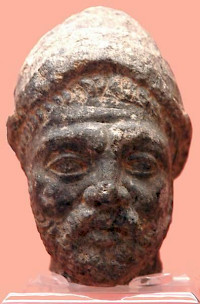Tiridates II
Tiridates II: pro-Roman rebel king of the Parthian Empire (r.36-37).

In 35 CE, the Parthian king Artabanus II installed his son Arsaces as king of Armenia, expelling the pro-Roman king Vonones. As a countermeasure, the Roman governor in Syria, Lucius Vitellius, invited Mithridates, a brother of the king of the West-Caucasian state of Iberia, to seize the Armenian throne. The result was a full-scale war between the Armenians and Iberians, in which nomads from Central Eurasia played a role as well. When Artabanus of Parthia tried to intervene, Vitellius ordered his legions (III Gallica, VI Ferrata, X Fretensis and XII Fulminata) to prepare for war (late 35?).
This was too much for Artabanus, who backed off and accepted the pro-Roman Mithridates of Iberia as the new king of Armenia. This was a great loss of face and many Parthians now started to ignore their oath of loyalty to Artabanus. At this moment, Vitellius introduced a Tiridates II, an Arsacid prince who had been living in Rome, and escorted him across the Euphrates, where the new Parthian leader was welcomed by several Parthian noblemen. Prince Tiridates continued to Seleucia and Ctesiphon, where a member of the Sûrên-clan crowned him king (36).
However, the new ruler hesitated too long and gave his rival, Artabanus II, who had found hospitality with king Izates of Adiabene, a second chance: using Scythian mercenaries, he marched on Seleucia and forced Tiridates to return to Vitellius, who could not intervene because there were problems in the south.
It may have been in late 37 or early 38 that Artabanus met Vitellius. The Parthian king, who had regained his throne, did obeisance to the standards of the Syrian legions, acknowledged Rome's superiority, and recognized that the crown of Armenia was not his to give away. It was one of the greatest triumphs of Rome's eastern policy. Tiridates' further fate is unknown.
Note
The chronology of the Arsacid kings of the Parthian Empire is less well-understood than, for example, the sequence of Seleucid and Ptolemaic kings or the emperors of Rome. This information is based on the researches by G.R.F. Assar, as published in "Iran under the Arsakids, 247 BC – AD 224/227" in: Numismatic Art of Persia (2011).